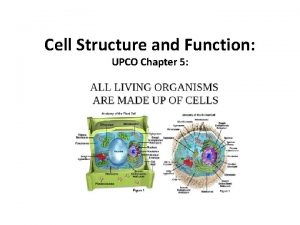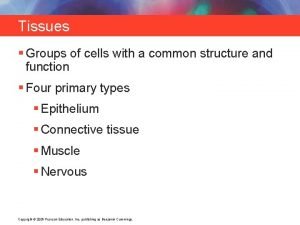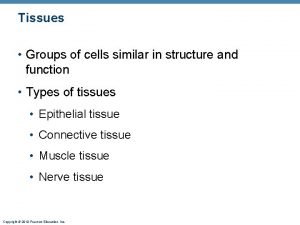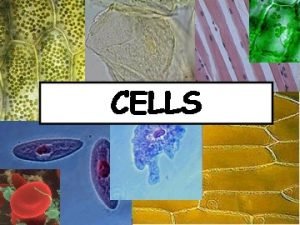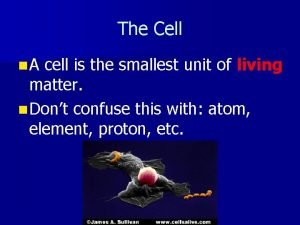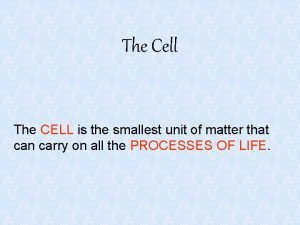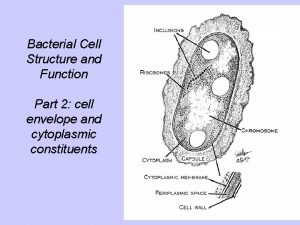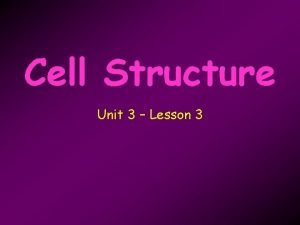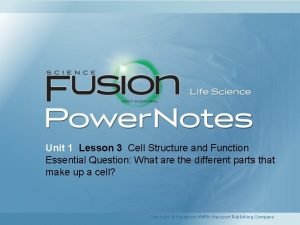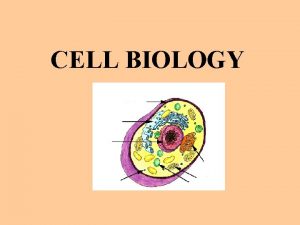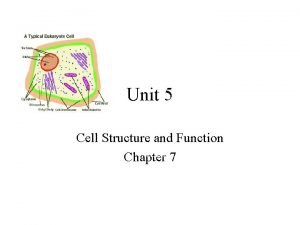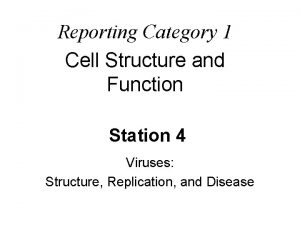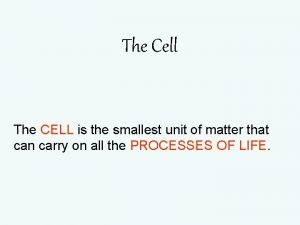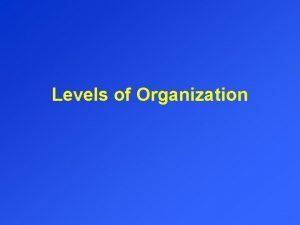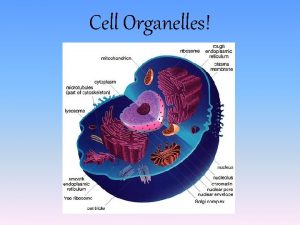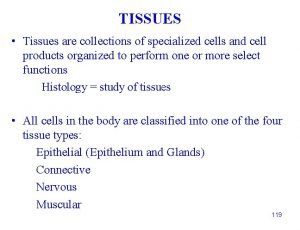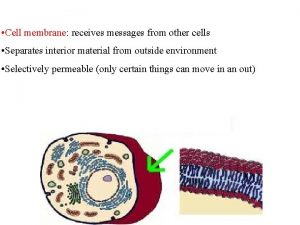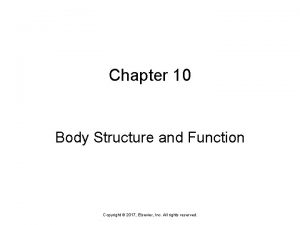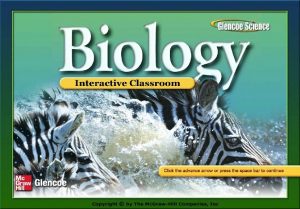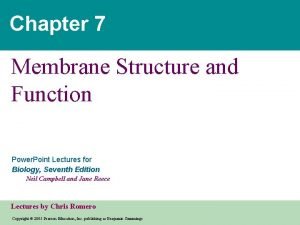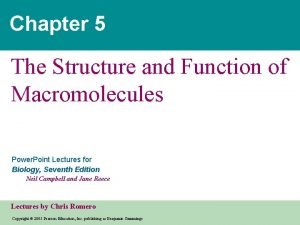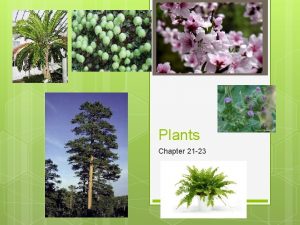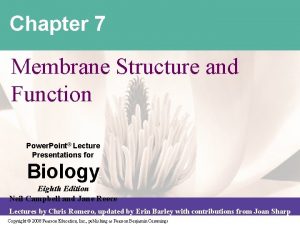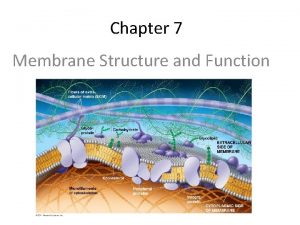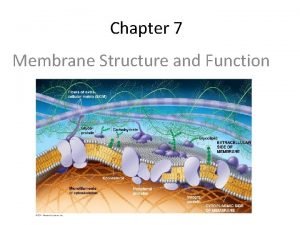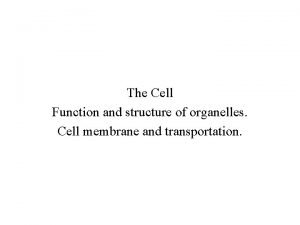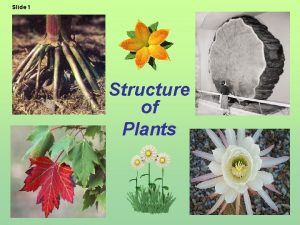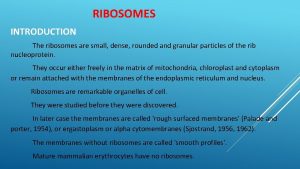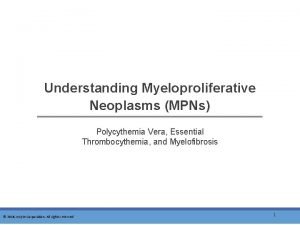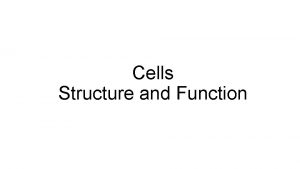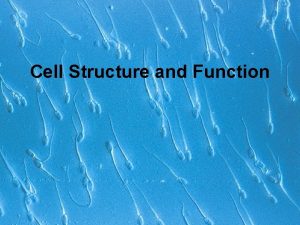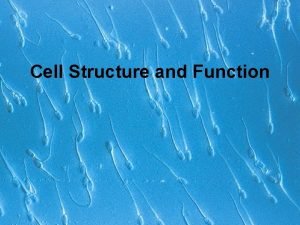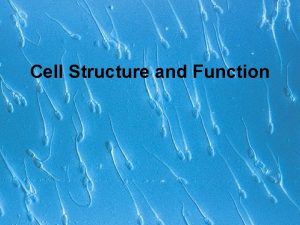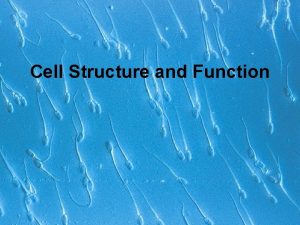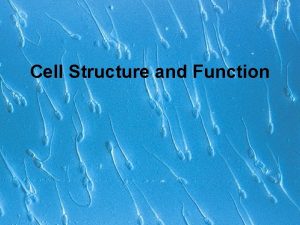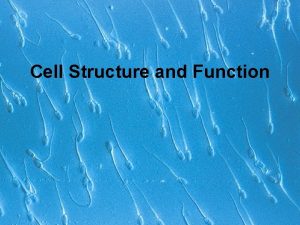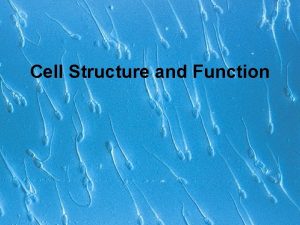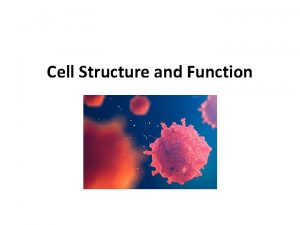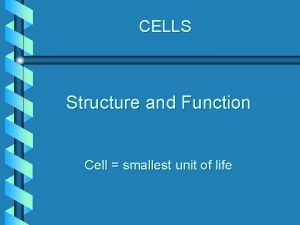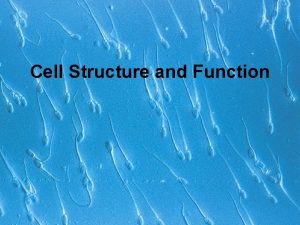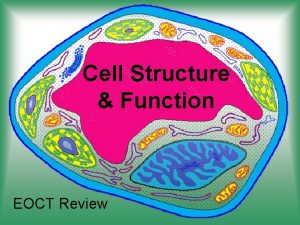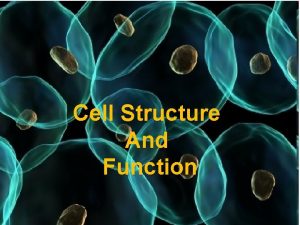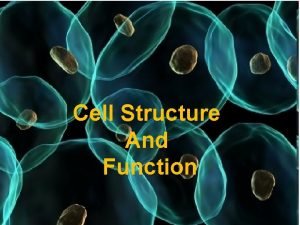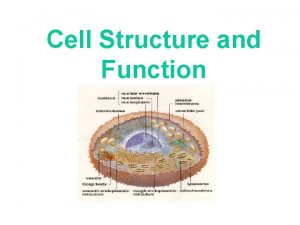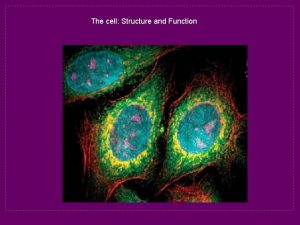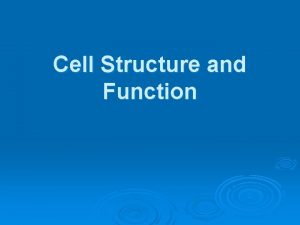Chapter 7 Cell Structure and Function Cells Smallest






































































- Slides: 70

Chapter 7: Cell Structure and Function

Cells • Smallest living unit • Most are microscopic

Discovery of Cells Robert Hooke (1665) • English physicist used primitive compound microscope to look at plant tissue (cork). • He called the chambers “cells” because they reminded him of the small rooms in a monastery

Cell theory • (1839)Theodor Schwann & Matthias Schleiden “ all living things are made of cells” • (50 yrs. later) Rudolf Virchow “all cells come from cells”

Principles of Cell Theory • All living things are made of cells • Smallest living unit of structure and function of all organisms is the cell • All cells arise from preexisting cells (this principle discarded the idea of spontaneous generation)

How small are cells? How much is a micrometer? ▫ 1 micrometer (µm) = 1/1, 000 m Typical cell size = 5 to 50 µm in diameter ▫ In a dice that is 1 cm 3 ▫ We could fit 1, 000 cells Cells Alive

How small are cells? Cell Size

Cells Have Large Surface Area-to-Volume Ratio

Two categories of cells 1. Prokaryotic Cells pro = before; karyon = nucleus or kernel • contain cell membranes and cytoplasm but no nucleus • DNA is scattered through cytoplasm examples: bacteria

Prokaryotic Cells • First cell type on earth • Cell type of Bacteria and Archaea

Prokaryotic Cells • No membrane bound nucleus • Nucleoid = region of DNA concentration • Organelles not bound by membranes

Two categories of cells 2. Eukaryotic Cells eu = true; karyon = nucleus or kernel contain a nucleus that holds DNA and membrane bound organelles that have specific functions examples: all plants, animals, some fungi, some microorganisms

Eukaryotic Cells • Nucleus bound by membrane • Include fungi, protists, plant, and animal cells • Possess many organelles Protozoan

Representative Animal Cell

Representative Plant Cell

7 -2 Cell Structures • Organelle – a specialized structure that performs a specific function inside a cell ▫ Two general kinds Derived from membranes Bacteria-like organelles Cytoplasm • Found – between the nucleus and cell membrane • Structure – a clear jelly-like fluid • Function – supports the organelles

Bacteria-Like Organelles • Derived from symbiotic bacteria • Ancient association • Endosymbiotic theory ▫ Evolution of modern cells from cells & symbiotic bacteria ▫ Mitochondria and chloroplast Structurally like bacteria Own DNA

The Nucleus • Nuclear Envelope ▫ Found: around the outside of the nucleus ▫ Structure: two thin membranes with thousands of pores ▫ Function: allows materials to move in and out of the nucleus.

The Nucleus Found – In cytoplasm near middle of cell Structure – filled with chromatin (tightly coiled DNA) Function: Contains the cell’s DNA, the instructions for making protein and directing cell activities. Chromatin Nucleus Nuclear Envelope

Nucleolus • Most cells have 2 or more • Directs synthesis of RNA • Forms ribosomes

Cytoskeleton Found: Throughout the cell Structure: A network of protein filaments • Microtubules (25 nm) • Microfilaments (7 nm) Function: Helps support the cell & maintain shape • Involved in several types of movement

Vacuoles • Found: In the cytoplasm • Structure: Saclike ▫ Very large in plant cells ▫ Smaller in animal cells • Function: Storage (water proteins, carbs, salts)

Vesicles • Found: In the cytoplasm • Structure: membrane bounded sac • Function: transports and/or stores cellular products

Lysosomes “The Cells Clean-up Crew” • Found: In the cytoplasm • Structure: Small enzyme filled organelles • Function: Breakdown large organic molecules, and old nonfunctioning organelles

Ribosomes • Found: In the cytoplasm • Structure: Small and grain-like, made of large and small subunits • Function: produce proteins from directions given by DNA

Endoplasmic Reticulum • Found: just outside the nucleus • Structure: a maze of membranes • Rough ER: (ribosomes imbedded in membrane) produces and transports proteins. • Smooth ER: No attached ribosomes ▫ Has enzymes that help build molecules Carbohydrates Lipids

Golgi Apparatus • Found: In the cytoplasm • Structure: A stack of membranes • Function: to modify, sort and package materials from the ER for storage or to be transported outside the cell.

Chloroplast Found: In the cytoplasm of plant cells Structure: Stack of membranes that contain photosynthetic pigments (chlorophyll) Function: Use energy from the sun to make food (photosynthesis)

Mitochondria “Powerhouse of the Cell” Found: In the cytoplasm Structure: Rod-shaped with a folded double membrane Function: Provide the cell with energy.

Cell Wall Found: Located outside the cell membrane Structure: Fibers of carbohydrate, cellulose in plant cells Function: Provide support and protection for the cell

Cell Membrane Found: Located around the perimeter of the cell Structure: Made of a phospholipid bilayer Function: Regulates what leaves and enters the cell and provides protection and support

Centrioles Found: Within the cytoplasm only in animal cells Structure: Made of a microtubules (tubulin) Function: Help organize the cell during division. Centrioles - Miosis

Cilia & Flagella • Provide motility • Cilia ▫ Short ▫ Used to move substances outside human cells • Flagella ▫ Whip-like extensions ▫ Found on sperm cells

7. 3 Cell Transport; Movement Across the Plasma Membrane • A few molecules move freely, WHY? ? ▫ Water, Carbon dioxide, Ammonia, Oxygen • Carrier proteins transport some molecules ▫ Proteins embedded in lipid bilayer ▫ Fluid mosaic model – describes fluid nature of a lipid bilayer with proteins

Plasma Membrane • Recall: Double layer of phospholipids & proteins

Membrane Proteins 1. Channels or transporters ▫ Move molecules in one direction 2. Receptors ▫ Recognize certain chemicals

Membrane Proteins 3. Glycoproteins ▫ Identify cell type 4. Enzymes ▫ Catalyze production of substances

Molecule Movement & Cells • Passive Transport • Active Transport • Endocytosis ▫ Phagocytosis ▫ Pinocytosis • Exocytosis

Passive Transport • No energy required • Move due to gradient ▫ differences in concentration, pressure, charge • Move to equalize gradient ▫ High moves toward low

Types of Passive Transport 1. Diffusion 2. Osmosis 3. Facilitated diffusion

Diffusion • Tendency of molecules to move from a higher concentration to a lower concentration until equilibrium is reached. • Equilibrium- a condition in which the concentration of a substance is equal throughout space. • Diffusion happens until the concentration of the molecules is even on both sides. NOTE: that doesn’t mean they stop moving!

Molecule 1 Molecule 2

Diffusion • Molecules move to equalize concentration • Diffusion video

Osmosis • Special form of diffusion • Fluid flows from lower solute concentration • Often involves movement of water ▫ Into cell ▫ Out of cell

Solution Differences & Cells • Recall: solvent + solute = solution • Hypotonic ▫ Solutes in cell more than outside ▫ Outside solvent will flow into cell • Isotonic ▫ Solutes equal inside & out of cell • Hypertonic ▫ Solutes greater outside cell ▫ Fluid will flow out of cell

Osmosis (an example of facilitated diffusion) • Diffusion of water through a selectively permeable membrane • Water molecules have a tough time passing through the cell membrane, why? • An aquaporin is a water channel protein

Osmosis • Does this process require energy?

1. the barrier is permeable to water but not to sugar. 2. There is more “free water” on the left side because there is less glucose 3. There is a net movement of water into the compartment containing the concentrated sugar solution. 4. Water will tend to move across the barrier until equilibrium is reached. 5. the concentrations of water and sugar will be the same on both sides.

Osmosis • Osmosis Video • The net movement in and out of the cell produces a force called osmotic pressure. • Osmotic pressure can cause cells to shrink or swell

Hypertonic • Solution with a higher concentration of solute and a lower concentration of water. • Hyper = above

Hypotonic • Solution with a lower solute concentration and a higher water concentration. • Hypo = below

Isotonic • Solutions of equal solute concentration. • Isos = equal

Effect on living animals Osmoregulation – control of water balance. ▫ Animals must use this when exposed to hypertonic and hypotonic environments for survival. ▫ Example – fresh water fish live in hypotonic environment use kidneys and gills to prevent excess water buildup in body.

Effect on living plant cells • Most plants thrive in a hypotonic environment when cell wall is turgid and vacuole is full. • Plants become wilted in isotonic environment. • Plasmolysis – plant in hypertonic environment causes cell water loss, cell shrivels and the cell membrane pulls away from the cell wall and can kill the cell.

Facilitated Diffusion • Differentially permeable membrane • Channels (are specific) help molecule or ions enter or leave the cell • Channels usually are transport proteins (aquaporins facilitate the movement of water) • No energy is used

Process of Facilitated Transport • Protein binds with molecule • Shape of protein changes • Molecule moves across membrane

Active Transport • Molecular movement • Requires energy (against gradient) • Example is sodium-potassium pump

Endocytosis • Movement of large material ▫ Particles ▫ Organisms ▫ Large molecules • Movement is into cells • Types of endocytosis ▫ bulk-phase (nonspecific) ▫ receptor-mediated (specific)

Process of Endocytosis • Plasma membrane surrounds material • Edges of membrane meet • Membranes fuse to form vesicle

Forms of Endocytosis • Phagocytosis – cell eating • Pinocytosis – cell drinking

Exocytosis • Reverse of endocytosis • Cell discharges material

Exocytosis • Vesicle moves to cell surface • Membrane of vesicle fuses • Materials expelled

7. 4 Homeostasis and Cells To maintain homeostasis, unicellular organisms grow, respond to the environment, transform energy, and reproduce. Unicellular organisms include both prokaryotes and eukaryotes.

• Prokaryotes: • bacteria remarkably adaptable and live almost everywhere—in the soil, on leaves, in the ocean, in the air, and even within the human body. Actinomycetes Tuberculosis

Single Celled Eukaryotes: algae, which contain chloroplasts and are found in oceans, lakes, and streams around the world, are single celled. Yeasts are also widespread. They play an important role in Breaking down complex nutrients, which makes them available for other organisms.

Multicellular Life • Cells in multicellular organisms do not live on their own, they work together. • Cells are specialized for different tasks and communicate with each other to maintain homeostasis. Specialized Pine Pollen Cells

Remember the levels of organization? Cell Tissue Organ System Organism

Cell Communication • Cells communicate through chemical signaling. (receptor proteins!) Signals can speed up or slow down the activities of the cells and can cause a cell to change what it is doing.

Signal molecule Receptor protein Second messenger

Cell Junctions • Cells attach to each other and hold together in tight formations. • Protein in the cell membrane recognizes the cell.
 Biology chapter 7 cell structure and function
Biology chapter 7 cell structure and function Chapter 7 cell structure and function section review 7-2
Chapter 7 cell structure and function section review 7-2 Chapter 5 cell structure and function
Chapter 5 cell structure and function Nondisjunction in meiosis
Nondisjunction in meiosis Groups of cells with a common structure and function.
Groups of cells with a common structure and function. Dense regular connective
Dense regular connective Tissues are groups of similar cells working together to:
Tissues are groups of similar cells working together to: What is the smallest unit of life
What is the smallest unit of life Cells are the smallest unit of life
Cells are the smallest unit of life Smallest cells
Smallest cells A cell is the smallest unit of life
A cell is the smallest unit of life Onodi cells
Onodi cells Red blood cells and white blood cells difference
Red blood cells and white blood cells difference Plant and animal cell venn diagram
Plant and animal cell venn diagram Masses of cells form and steal nutrients from healthy cells
Masses of cells form and steal nutrients from healthy cells Function of cells
Function of cells Chapter 4 cell theory and cell study
Chapter 4 cell theory and cell study What is part 2
What is part 2 Lesson 3 cell structure and function answer key
Lesson 3 cell structure and function answer key Cell structure and function organizer
Cell structure and function organizer Plant cell structure and function
Plant cell structure and function Lesson 3 cell structure and function answer key
Lesson 3 cell structure and function answer key Cell organelle graphic organizer
Cell organelle graphic organizer Cell structure and function
Cell structure and function Unit 5 cell structure and function answer key
Unit 5 cell structure and function answer key Category 1 cell structure and function
Category 1 cell structure and function Category 1 cell structure and function
Category 1 cell structure and function Category 1 cell structure and function
Category 1 cell structure and function Loop of henle
Loop of henle Thyroid parafollicular cells
Thyroid parafollicular cells Somatic vs gamete
Somatic vs gamete Somatic cells vs germ cells
Somatic cells vs germ cells Prokaryotic cells
Prokaryotic cells Prokaryotic cells vs eukaryotic cells
Prokaryotic cells vs eukaryotic cells The organelle trail
The organelle trail Label
Label Cuál es la diferencia entre la célula animal y vegetal
Cuál es la diferencia entre la célula animal y vegetal Prokaryotic cells vs eukaryotic cells
Prokaryotic cells vs eukaryotic cells Cells cells they're made of organelles meme
Cells cells they're made of organelles meme Smallest cell organelle
Smallest cell organelle Which of the following is the smallest part of a plant
Which of the following is the smallest part of a plant Smallest organelle
Smallest organelle Collection of specialized cells and cell products
Collection of specialized cells and cell products Germ cell vs somatic cells
Germ cell vs somatic cells Advantages and disadvantages of diaphragm cell process
Advantages and disadvantages of diaphragm cell process Prokaryotic cell and eukaryotic cell similarities
Prokaryotic cell and eukaryotic cell similarities Plant cell animal cell venn diagram
Plant cell animal cell venn diagram Vacuole function
Vacuole function Primary cell and secondary cell
Primary cell and secondary cell Differences between plant animal and bacterial cells
Differences between plant animal and bacterial cells Section 10-2 cell division
Section 10-2 cell division Life
Life Idealized plant cell
Idealized plant cell Walker cell and hadley cell
Walker cell and hadley cell Cell cycle and cell division
Cell cycle and cell division Mitosis
Mitosis Voltaic vs electrolytic cells
Voltaic vs electrolytic cells Animal cell and plant cell
Animal cell and plant cell Chapter 10 body structure and function
Chapter 10 body structure and function Chapter 22 plant structure and function answer key
Chapter 22 plant structure and function answer key Chapter 7 membrane structure and function
Chapter 7 membrane structure and function Chapter 5 the structure and function of macromolecules
Chapter 5 the structure and function of macromolecules Chapter 21 plant structure and function
Chapter 21 plant structure and function Chapter 7 membrane structure and function
Chapter 7 membrane structure and function Flaccid cell
Flaccid cell Chapter 7 membrane structure and function
Chapter 7 membrane structure and function Section 23-4 leaves
Section 23-4 leaves How cells function
How cells function 3 functions of leaves
3 functions of leaves Introduction of ribosomes
Introduction of ribosomes White blood cells function
White blood cells function


